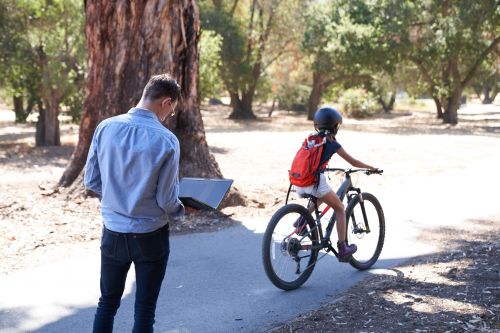A version of this article ran in the February issue of Bicycle Retailer and Industry News. Retailers can get the print or digital version of the magazine free — subscribe at this link.
PALO ALTO, Calif. — In addition to giving more kids access to bikes and places to ride, the nonprofit Outride organization also studies cycling’s cognitive and physical benefits.
“At the end of the day, what would be a dream for us would be for the information and evidence to get out there for people and parents to go, ‘This is very real,’” said Mike Sinyard, Specialized Bicycles founder and co-founder of Outride.
A decade after Sinyard helped start the program that would research how cycling could benefit kids with Attention Deficit Hyperactivity Disorder, that day might be here, and it might lead to more kids turning pedals instead of only taking pills.
At the Outride Summit in October, research conducted with Stanford University showed cycling activates the brain “to engage the hunting, gathering, and foraging systems,” said Dr. Allan L. Reiss at the summit. “These are the most effective for improving and sustaining brain health. What are these systems? They utilize a combination of spatial orientation, and navigation, body awareness, memory, motor control, balance and coordination, and executive function — planning, sequence, flexibility, inhibition, etc. What type of exercise does this sound like to you? It sounds like cycling, right? This is exactly what cycling does.”
At the summit, Reiss, who’s with the Stanford School of Medicine and whose lab specializes in exercise neuroscience, noted evidence-based findings of why exercise is important, which includes improving cardio health, bone and muscle health, metabolic health, and lowering the risk of most cancers.
Last but not least, Reiss said exercise — especially cycling — improves brain health.
“What’s great about cycling is you can do it in groups,” Reiss said during his presentation, also noting cycling’s benefits can help aging adults in dementia prevention. “Doing it in groups in the natural environment. Being in the natural environment amplifies that positive effect on those brain systems even more. We are doing the study outside and inside just so we can compare the two and understand how the natural environment affects the brain.”
The study moves outside
A video of a girl study participant riding her bike outside the Stanford test lab was shown during the summit. She was wearing a brain imaging device — similar to an MRI — worn under her helmet that was plugged into a transmitter tucked into a backpack.
The girl went for a 20-minute ride outside the Stanford test lab, and brain activity was measured and diagrammed in real time on a laptop by a nearby researcher. The device shows when precise areas of the brain are active.
“We hear a lot about how cycling is good for your body, it’s good for your heart, and this idea that it’s also good for the brain is less publicized,” said Esther Walker, Outride research manager. “It really goes beyond just thinking about exercise and weight and things like that and instead more holistically thinking about how sharp you’re feeling throughout the day and your mental health.”
Walker said kids who were outside riding their bike more often during the COVID-19 pandemic reported fewer symptoms of depression and anxiety, and that daily activity can encourage more brain cells to develop leading to better brain function.
“And that also can result in strong connections between the brain cells that will ultimately impact memory and learning,” she said. “These are really important changes that happen in the brain as a result of riding the bike and can seep into your everyday activity — whether that’s focusing at school or completing a complex exam — that is really exciting, and there’s less awareness about that side of it.”
A natural ADHD treatment
Cycling’s benefit for sufferers of ADHD has a personal meaning for Sinyard, who suffers from the disorder.
“All exercise is good, but there’s something about the zen-like motion of pedaling and the sensory balance, plus it’s fun,” he said. “We have an opiate crisis today, and I believe there will be a crisis that is going to come out with overmedicating our children.”
Walker also noted that Reiss’ research is looking at how the brain changes during a bike ride, which is important because previous research only looked at a snapshot before and after a ride.
“But really what’s happening when you’re out on a trail feeling that flow state,” Walker said. “That’s unknown. So they’re going to be one of the first groups looking at what’s actually happening when you’re out on the bike.”
Reiss said the brain imaging device costs $600,000 with a grant coming from the National Institute of Health. The helmet used in the test was manufactured by Specialized under the direction of Stanford to accommodate the sensor, and it wasn’t just a case of removing padding.
“In putting that cap on, there’s all of these different modules that are going to be sensitive to movement and light, so they had to construct the helmet in a way that was secure but also still comfortable to the participant and also safe,” Walker said.
While the highlight was the research team’s findings, the summit also detailed how Outride’s Riding for Focus school cycling programs have impacted academics and improved student mental health. This will be the 11th season since the initial school pilot program with more than 50,000 students participating each year. Walker noted that the percentage of kids in the program who haven’t ridden a bike varies across the country, depending on rural or urban settings and socioeconomic factors.
“We have some schools where it might be 5%. We have schools we’re working with where over 50% of the class had never ridden a bike, and those are actually the schools where we’re making a huge impact. A lot of those students might be shy, but when they see their peers are also in the same spot in having to learn to ride, they build confidence together.”
Since 2014, more than 250 schools have partnered with Outride, which also has granted more than $1.5 million to more than 170 community cycling programs through its Outride Fund.


